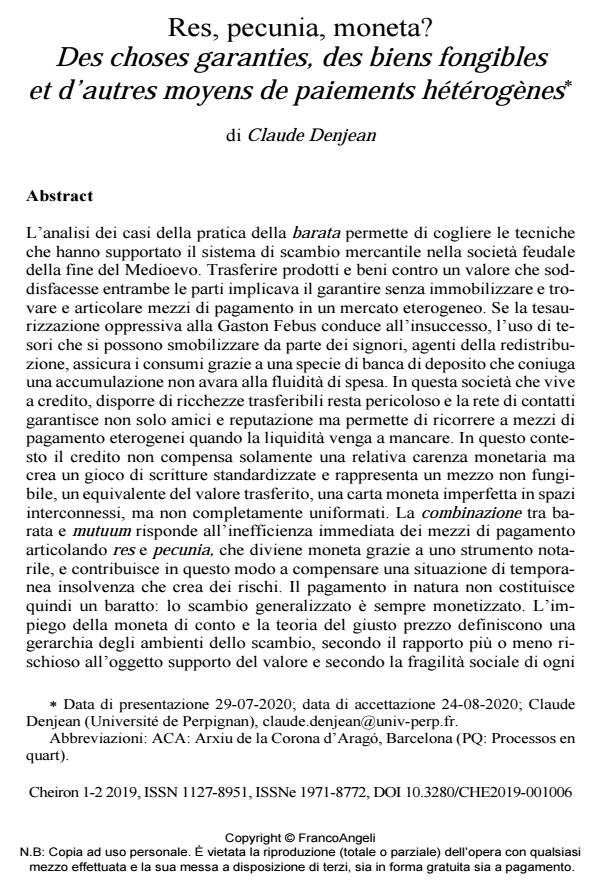Res, pecunia, moneta? Des choses garanties, des biens fongibles et d’autres moyens de paiements hétérogènes
Journal title CHEIRON
Author/s Claude Denjean
Publishing Year 2021 Issue 2019/1-2
Language French Pages 31 P. 111-141 File size 223 KB
DOI 10.3280/CHE2019-001006
DOI is like a bar code for intellectual property: to have more infomation
click here
Below, you can see the article first page
If you want to buy this article in PDF format, you can do it, following the instructions to buy download credits

FrancoAngeli is member of Publishers International Linking Association, Inc (PILA), a not-for-profit association which run the CrossRef service enabling links to and from online scholarly content.
Analyzing the practices of the barata, we can understand the tech-niques which supported the trading system of the feudal society of the late Middle Ages. Transferring products and goods against a return val-ue and satisfy both parties implied guaranteeing without immobilizing, finding payment instruments in a heterogeneous market. If the oppres-sive hoarding of Gaston Febus looks like to usurer’s failure, using mo-bilizable treasures of redistributing lords ensures consumption through a kind of deposit bank and offers non-avaricious reserve and fluidity of expenses. To have transferable wealth remains perilous in this so-ciety of credit. Working in a network not only ensures friends partners and reputation but articulates heterogeneous means of payment when the liquidity would be lacking more than the cash. The credit does not only compensate for a relative monetary deficiency. It founds a set of uniform writings, a non-fungible medium, equivalent to goods trans-ferred, imperfect paper money, in interconnected but incompletely standardized spaces. Combining barata and mutuum when means of payment are not effective takes care on temporary insolvency which increases risk. However, it may be an anti-usurious accusation against who does not respect fair price. Paying in kind is not really bartering. The exchange, generalized, is always monetized. The use of a currency of account and the theory of the fair price lead to hierarchy within the people’s individual positions, according to the more or less risky rela-tion with the things which support value and according to the social fragility of each actor, from the money changer to the usurer. Immobi-lizing a few but enough money by efficient and legal solutions, using credit avoiding the risk of bankruptcy, by controlling the acceleration of transactions and the secondary markets: all these means allowed to establish dialectical relations between norm and practice, chivalrous and merchant culture.
L’analisi dei casi della pratica della barata permette di cogliere le tec-niche che hanno supportato il sistema di scambio mercantile nella so-cietà feudale della fine del Medioevo. Trasferire prodotti e beni contro un valore che soddisfacesse entrambe le parti implicava il garantire senza immobilizzare e trovare e articolare mezzi di pagamento in un mercato eterogeneo. Se la tesaurizzazione oppressiva alla Gaston Febus conduce all’insuccesso, l’uso di tesori che si possono smobilizzare da parte dei signori, agenti della redistribuzione, assicura i consumi grazie a una specie di banca di deposito che coniuga una accumulazione non avara alla fluidità di spesa. In questa società che vive a credito, dispor-re di ricchezze trasferibili resta pericoloso e la rete di contatti garantisce non solo amici e reputazione ma permette di ricorrere a mezzi di pa-gamento eterogenei quando la liquidità venga a mancare. In questo contesto il credito non compensa solamente una relativa carenza mone-taria ma crea un gioco di scritture standardizzate e rappresenta un mez-zo non fungibile, un equivalente del valore trasferito, una carta moneta imperfetta in spazi interconnessi, ma non completamente uniformati. La combinazione tra barata e mutuum risponde all’inefficienza imme-diata dei mezzi di pagamento articolando res e pecunia, che diviene moneta grazie a uno strumento notarile, e contribuisce in questo modo a compensare una situazione di temporanea insolvenza che crea dei ri-schi. Il pagamento in natura non costituisce quindi un baratto: lo scam-bio generalizzato è sempre monetizzato. L’impiego della moneta di conto e la teoria del giusto prezzo definiscono una gerarchia degli am-bienti dello scambio, secondo il rapporto più o meno rischioso all’oggetto supporto del valore e secondo la fragilità sociale di ogni at-tore, dall’agente di cambio all’usuraio. Immobilizzare poco ma in mi-sura sufficiente, attraverso degli strumenti sani e legali, utilizzare il credito evitando il rischio del fallimento, dominando l’accelerazione delle transazioni e i mercati secondari: tutto ciò permette di fondare i rapporti dialettici tra norma e pratica, cultura cavalleresca e mercantile.
Keywords: Feudal society; Barter, Account money; Payment systems; Chivalrous and mercantile culture.
- Mezzi di scambio non monetari. Merci e servizi come monete alternative nelle economie dei secoli XIII-XVIII / Alternative currencies. Commodities and services as exchange currencies in the monetarized economies of the 13th to 18th centuries Rachele Scuro, pp.357 (ISBN:979-12-215-0347-0)
Claude Denjean, Res, pecunia, moneta? Des choses garanties, des biens fongibles et d’autres moyens de paiements hétérogènes in "CHEIRON" 1-2/2019, pp 111-141, DOI: 10.3280/CHE2019-001006